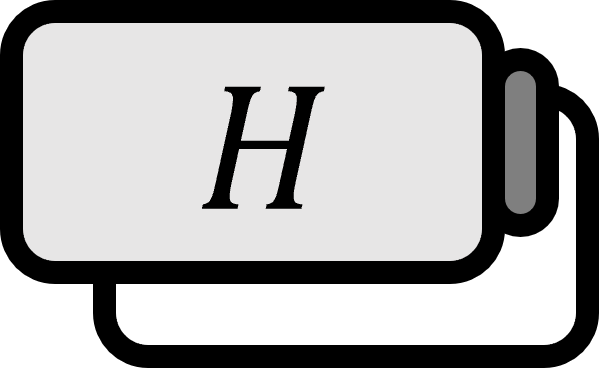내적 공간에서 정의된 내적과 연관된 놈의 성질
정리1
내적 공간 $\left( X, \langle \cdot,\cdot \rangle \right)$가 주어졌다고 하자. 그러면 자연스럽게 $\left\| \cdot \right\|:=\sqrt{\left\langle \cdot,\cdot \right\rangle }$와 같이 놈을 정의할 수 있고 아래의 성질들이 성립한다.
(a) 코시-슈바르츠 부등식: 임의의 $\mathbf{x}, \mathbf{y}\in X$에 대해서,
$$ \left| \langle \mathbf{x},\mathbf{y} \rangle \right| \le \left\| \mathbf{x} \right\| \left\| \mathbf{y} \right\| $$
(b) 평행사변형 법칙: 임의의 $\mathbf{x},\mathbf{y}\in X$에 대해서,
$$ \left\| \mathbf{x} + \mathbf{y} \right\|^{2} + \left\| \mathbf{x} - \mathbf{y} \right\|^{2} = 2 \left( \left\| \mathbf{x} \right\| ^{2}+ \left\| \mathbf{y} \right\| ^{2} \right) $$
(c) The polarization identity in a complex vector space: 복소내적공간 $X$와 임의의 $\mathbf{x},\mathbf{y}\in X$에 대해서,
$$ \langle \mathbf{x},\mathbf{y} \rangle = \frac{1}{4} \Big( \left\| \mathbf{x} + \mathbf{y} \right\|^{2} - \left\| \mathbf{x} - \mathbf{y} \right\|^{2} + i \left( \left\| \mathbf{x} + i\mathbf{y} \right\|^{2} - \left\| \mathbf{x} - i\mathbf{y} \right\|^{2} \right) \Big) $$
(d) The polarization identity in a real vector space: 실내적공간 $X$와 임의의 $\mathbf{x},\mathbf{y}\in X$에 대해서,
$$ \langle \mathbf{x},\mathbf{y}\rangle = \frac{1}{4} \left( \left\| \mathbf{x}+\mathbf{y} \right\|^{2} - \left\| \mathbf{x}-\mathbf{y} \right\| ^{2} \right) $$
(e) Norm versus inner product: 임의의 $\mathbf{x} \in X$에 대해서,
$$ \left\| \mathbf{x} \right\| =\sup \left\{ \left| \langle \mathbf{x},\mathbf{y} \rangle \right| : \mathbf{y}\in X, \left\| \mathbf{y} \right\| =1 \right\} $$
증명
(a)
내적공간에서 놈의 정의에 따라 코시-슈바르츠 부등식은
$$ \begin{align*} \left| \langle \mathbf{x},\mathbf{y}\rangle \right| & \le \langle \mathbf{x},\mathbf{x} \rangle^{1/2} \langle \mathbf{y},\mathbf{y} \rangle ^{1/2} \\ =&\ \left\| \mathbf{x} \right\| \left\| \mathbf{y} \right\| \end{align*} $$
■
(b)
$$ \begin{align*} \left\| \mathbf{x} + \mathbf{y} \right\|^{2} + \left\| \mathbf{x} - \mathbf{y} \right\|^{2} =&\ \langle \mathbf{x}+\mathbf{y}, \mathbf{x}+\mathbf{y}\rangle + \langle \mathbf{x}-\mathbf{y},\mathbf{x}-\mathbf{y} \rangle \\ =&\ \langle \mathbf{x},\mathbf{x} \rangle + \langle \mathbf{x},\mathbf{y}\rangle + \langle \mathbf{y},\mathbf{x} \rangle + \langle \mathbf{y},\mathbf{y} \rangle \\ & + \langle \mathbf{x},\mathbf{x} \rangle -\langle \mathbf{x},\mathbf{y}\rangle -\langle \mathbf{y},\mathbf{x} \rangle + \langle \mathbf{y},\mathbf{y} \rangle \\ =&\ 2 \langle \mathbf{x},\mathbf{x} \rangle + 2 \langle \mathbf{y},\mathbf{y} \rangle \\ =&\ 2 \left(\langle \mathbf{x},\mathbf{x} \rangle + \langle \mathbf{y},\mathbf{y} \rangle \right) \\ =&\ 2 \left( \left\| \mathbf{x} \right\|^{2} + \left\| \mathbf{y} \right\|^{2} \right) \end{align*} $$
■
(c)
증명 (b) 를 참고하면 실수 부분의 계산 결과를 얻을 수 있다.
$$ \begin{align*} \left\| \mathbf{x} + \mathbf{y} \right\|^{2} -\left\| \mathbf{x} - \mathbf{y} \right\|^{2} =&\ 2 \langle \mathbf{x},\mathbf{y}\rangle + 2 \langle \mathbf{y},\mathbf{x}\rangle \end{align*} $$
허수 부분을 계산해보면 다음과 같다.
$$ \begin{align*} \left\| \mathbf{x} + i\mathbf{y} \right\|^{2} =&\ \langle \mathbf{x}+i\mathbf{y} , \mathbf{x}+i\mathbf{y} \rangle \\ =&\ \langle \mathbf{x},\mathbf{x}\rangle + \langle \mathbf{x},i\mathbf{y}\rangle + \langle i\mathbf{y},\mathbf{x}\rangle +\langle i\mathbf{y},i\mathbf{y}\rangle \\ =&\ \langle \mathbf{x},\mathbf{x}\rangle -i\langle \mathbf{x},\mathbf{y}\rangle + i\langle \mathbf{y},\mathbf{x}\rangle +\langle \mathbf{y},\mathbf{y} \rangle \end{align*} $$
그리고
$$ \begin{align*} \left\| \mathbf{x} - i\mathbf{y} \right\|^{2} =&\ \langle \mathbf{x}-i\mathbf{y} , \mathbf{x}-i\mathbf{y}\rangle \\ =&\ \langle \mathbf{x},\mathbf{x}\rangle - \langle \mathbf{x},i\mathbf{y}\rangle - \langle i\mathbf{y},\mathbf{x}\rangle +\langle i\mathbf{y},i\mathbf{y}\rangle \\ =&\ \langle \mathbf{x},\mathbf{x}\rangle +i\langle \mathbf{x},\mathbf{y}\rangle -i\langle \mathbf{y},\mathbf{x}\rangle +\langle \mathbf{y},\mathbf{y} \rangle \end{align*} $$
따라서
$$ \left\| \mathbf{x} + i\mathbf{y} \right\|^{2} - \left\| \mathbf{x} - i\mathbf{y} \right\|^{2} = -2i \langle \mathbf{x},\mathbf{y} \rangle +2i\langle \mathbf{y},\mathbf{x} \rangle $$
그러므로
$$ \begin{align*} & \left\| \mathbf{x} + \mathbf{y} \right\|^{2} - \left\| \mathbf{x} - \mathbf{y} \right\|^{2} + i \left(\left\| \mathbf{x} + i\mathbf{y} \right\|^{2} - \left\| \mathbf{x} - i\mathbf{y} \right\|^{2} \right) \\ =&\ 2 \langle \mathbf{x},\mathbf{y} \rangle + 2 \langle \mathbf{y},\mathbf{x} \rangle +2\langle \mathbf{x},\mathbf{y} \rangle -2 \langle \mathbf{y},\mathbf{x} \rangle \\ =&\ 4 \langle \mathbf{x},\mathbf{y} \rangle \end{align*} $$
■
(d)
$\langle \mathbf{x},\mathbf{y} \rangle \in \mathbb{R}$이면 $\langle \mathbf{x},\mathbf{y} \rangle=\overline{\langle \mathbf{y},\mathbf{x} \rangle}=\langle \mathbf{y},\mathbf{x} \rangle$이므로
$$ \begin{align*} \left\| \mathbf{x} + \mathbf{y} \right\| ^{2} -\left\| \mathbf{x} - \mathbf{y} \right\| ^{2} =&\ 2 \langle \mathbf{x},\mathbf{y}\rangle + 2 \langle \mathbf{y},\mathbf{x}\rangle \\ =&\ 4\langle \mathbf{x},\mathbf{y} \rangle \end{align*} $$
■
(e)
코시-슈바르츠 부등식에 의해
$$ \left| \left\langle \mathbf{x},\mathbf{y} \right\rangle \right| \le \left\| \mathbf{x} \right\| \left\| \mathbf{y} \right\| $$
그러면 다음의 식이 성립한다.
$$ \sup \limits_{\left\| \mathbf{y} \right\|=1 } \left| \left\langle \mathbf{x},\mathbf{y} \right\rangle \right| \le \left\| \mathbf{x} \right\| $$
이때 $\mathbf{y}=\dfrac{\mathbf{x}}{\left\| \mathbf{x} \right\| }$로 두면 $\left\| \mathbf{y} \right\| = 1$이고
$$ \begin{align*} \left| \left\langle \mathbf{x},\mathbf{y} \right\rangle \right| =&\ \left| \left\langle \mathbf{x}, \frac{\mathbf{x}}{\left\| \mathbf{x} \right\| } \right\rangle \right| \\ =&\ \frac{1}{\left\| \mathbf{x} \right\| } \left\langle \mathbf{x},\mathbf{x} \right\rangle \\ =&\ \frac{1}{\left\| \mathbf{x} \right\| }\left\| \mathbf{x} \right\|^{2} \\ =&\ \left\| \mathbf{x} \right\| \end{align*} $$
가 성립한다. 따라서
$$ \sup \limits_{\left\| \mathbf{y} \right\|=1 } \left| \left\langle \mathbf{x},\mathbf{y} \right\rangle \right| = \left\| \mathbf{x} \right\| $$
■
Ole Christensen, Functions, Spaces, and Expansions: Mathematical Tools in Physics and Engineering (2010), p64-65 ↩︎

 저희들의 저서 「줄리아 프로그래밍」이 2024 세종도서 학술부문에 선정되었습니다!
저희들의 저서 「줄리아 프로그래밍」이 2024 세종도서 학술부문에 선정되었습니다!

